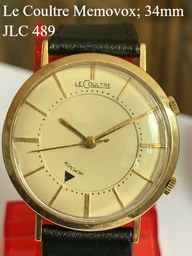Jaeger Le Coultre
Jaeger Le Coultre (JLC) is one of the oldest still active watch manufacture. It played very important role in a development of alarm wrist watches, first model (489) was introduced already in 1949. Development of the alarm movements continued until today without any time gaps and by this JLC has the longest tradition in this field of watch industry. Almost all (exception is 601 model) watches use alarm disc instead alarm hand.
Very common version of their watches has the name just "Le Coultre". This brand was used for the USA market, where movements and watches were assembled due to custom reasons. But those watches are original JLC watches with the original JLC movements.
Instruction manual:
All JLC movements have the same operation system. Only the newest models have some additonal features.
Upper crown in position 0: Winding the alarm. Alarm rings.
Upper crown in position 1: Setting the alarm. Alarm does not ring.
Lower crown in position 0: Winding the time (in automatic movement winding is automatic but hand winding is possible).
Lower crown in position 1: Setting the time.
For the date movements date can be set by passing midnight. Exceptions are 912/956 models where quick set date exists. Upper crown in position 1 is used for setting alarm (turning crown anti clockwise) or setting date (turning crown clockwise).
As an exception, model World time extreme alarm has a pusher for On/Off alarm setting.
Manual wind movements (489; 601; 814; 910; 914)
As stated, first alarm movement with the name 489 was developed in 1949. It's two spring barrels two crowns type of the movement. In 1954 the first modification of the movement was done, code for this movement is 814. It's quite simmilar to 489, the visible change is the unified bridge (at 489 bridge was split to two parts). Based on 814 also version 601 was developed, this is the only movement which has alarm hand and not alarm disc. Less than 2000 watches were made with 601 movement.
In 1962 movement 814 was replaced by 910, which is bigger and has some technical improvements. Also the first version with date complication was added (911 - it's 910 with date). Last improvement was done in 1996 with the model 914, where alarm pin was replaced by tone spring. Also model 914 is the only movement with 18 jewels, all others have 17 jewels. 914 movement is certified as "master" (i.e. at least 1000 hours testing passed before going to the market).










Automatic movements (815; 825; 916; 917; 918; 909; 912; 956)
In 1956 based on hand winding movement 814 the first automatic movement 815 was developed. Technicaly 815 is almost indentical to 814, except rotor, of course. Since alarm pin was placed near the centre of the movement, rotor needed some specific modification - it has hole in the middle and rotor rotates arround the pin. Three years later date complication was added and this movement got the name 825.
In 1969 825 was modified to 916, the main difference was exactly the pin position and the change of the rotor. 916 made for Fabre-Leube has a 917 code name. In 1996 another refreshment was released (918). This movement has 22 jewels, all previous ones have 17 jewels.
Based on 916 movement also the modular 919 movement was developed where perpetual calendar complication module was added to 916. Watch with this movement is called Grand Reveil. Later editions of Grand Reveil have 909 movement which is 918 movement with same perpetual module as 919 has.
The newest models of the alarm movements are 912/956. 956 is based od 918 but resonanting gong is implemented instead of tone spring. Also quick set date is finally implemented. 912 is 956 with additional 24h complication. Both movements have 23 jewels.
It is important to point out that in ALL automatic movements only time spring barrel is powered automaticaly, whereas alarm stays manual winded. JLC says that this approach gives more control to the user meaning, one knows for sure weather alarm is winded or not.








